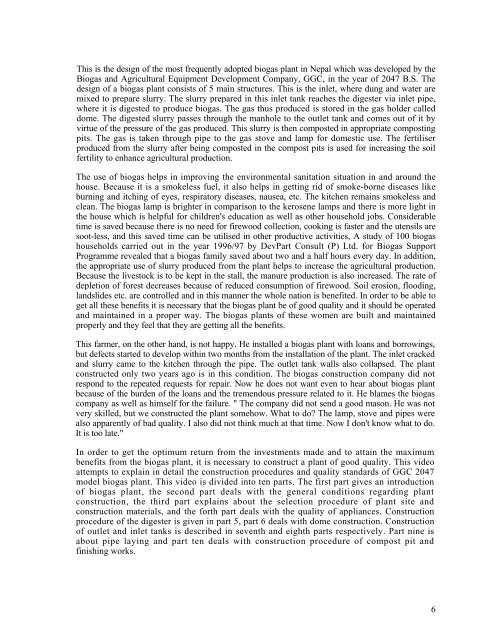Download - SNV
Download - SNV
Download - SNV
You also want an ePaper? Increase the reach of your titles
YUMPU automatically turns print PDFs into web optimized ePapers that Google loves.
This is the design of the most frequently adopted biogas plant in Nepal which was developed by the<br />
Biogas and Agricultural Equipment Development Company, GGC, in the year of 2047 B.S. The<br />
design of a biogas plant consists of 5 main structures. This is the inlet, where dung and water are<br />
mixed to prepare slurry. The slurry prepared in this inlet tank reaches the digester via inlet pipe,<br />
where it is digested to produce biogas. The gas thus produced is stored in the gas holder called<br />
dome. The digested slurry passes through the manhole to the outlet tank and comes out of it by<br />
virtue of the pressure of the gas produced. This slurry is then composted in appropriate composting<br />
pits. The gas is taken through pipe to the gas stove and lamp for domestic use. The fertiliser<br />
produced from the slurry after being composted in the compost pits is used for increasing the soil<br />
fertility to enhance agricultural production.<br />
The use of biogas helps in improving the environmental sanitation situation in and around the<br />
house. Because it is a smokeless fuel, it also helps in getting rid of smoke-borne diseases like<br />
burning and itching of eyes, respiratory diseases, nausea, etc. The kitchen remains smokeless and<br />
clean. The biogas lamp is brighter in comparison to the kerosene lamps and there is more light in<br />
the house which is helpful for children's education as well as other household jobs. Considerable<br />
time is saved because there is no need for firewood collection, cooking is faster and the utensils are<br />
soot-less, and this saved time can be utilised in other productive activities, A study of 100 biogas<br />
households carried out in the year 1996/97 by DevPart Consult (P) Ltd. for Biogas Support<br />
Programme revealed that a biogas family saved about two and a half hours every day. In addition,<br />
the appropriate use of slurry produced from the plant helps to increase the agricultural production.<br />
Because the livestock is to be kept in the stall, the manure production is also increased. The rate of<br />
depletion of forest decreases because of reduced consumption of firewood. Soil erosion, flooding,<br />
landslides etc. are controlled and in this manner the whole nation is benefited. In order to be able to<br />
get all these benefits it is necessary that the biogas plant be of good quality and it should be operated<br />
and maintained in a proper way. The biogas plants of these women are built and maintained<br />
properly and they feel that they are getting all the benefits.<br />
This farmer, on the other hand, is not happy. He installed a biogas plant with loans and borrowings,<br />
but defects started to develop within two months from the installation of the plant. The inlet cracked<br />
and slurry came to the kitchen through the pipe. The outlet tank walls also collapsed. The plant<br />
constructed only two years ago is in this condition. The biogas construction company did not<br />
respond to the repeated requests for repair. Now he does not want even to hear about biogas plant<br />
because of the burden of the loans and the tremendous pressure related to it. He blames the biogas<br />
company as well as himself for the failure. " The company did not send a good mason. He was not<br />
very skilled, but we constructed the plant somehow. What to do? The lamp, stove and pipes were<br />
also apparently of bad quality. I also did not think much at that time. Now I don't know what to do.<br />
It is too late."<br />
In order to get the optimum return from the investments made and to attain the maximum<br />
benefits from the biogas plant, it is necessary to construct a plant of good quality. This video<br />
attempts to explain in detail the construction procedures and quality standards of GGC 2047<br />
model biogas plant. This video is divided into ten parts. The first part gives an introduction<br />
of biogas plant, the second part deals with the general conditions regarding plant<br />
construction, the third part explains about the selection procedure of plant site and<br />
construction materials, and the forth part deals with the quality of appliances. Construction<br />
procedure of the digester is given in part 5, part 6 deals with dome construction. Construction<br />
of outlet and inlet tanks is described in seventh and eighth parts respectively. Part nine is<br />
about pipe laying and part ten deals with construction procedure of compost pit and<br />
finishing works.<br />
6
















